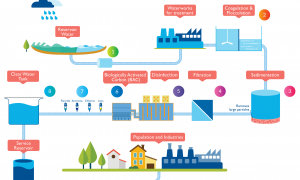🕑 Reading time: 1 minute
Groundwater is an important natural resource. The precipitation infiltrates into the ground and travels down until it reaches the impervious stratum where it is stored as groundwater. It is stored in the pores present in the geological formations such as soil, rock, sand, etc.
Contents:
Types of Geological Formations of Groundwater
There are four different types of geological formations of groundwater :
- Aquifer
- Aquitard
- Aquiclude
- Aquifuge
1. Aquifer
An aquifer is a saturated formation of the earth. It not only stores the water but also yields it in adequate quantity. Aquifers are highly permeable formations and hence they are considered as main sources of groundwater applications. Unconsolidated deposits of sand and gravel are examples of an aquifer.
Aquifers are classified into two types based on their occurrence which are as follows :
- Unconfined aquifer
- Confined Aquifer
Unconfined aquifer
An unconfined aquifer is an aquifer which has free water surface - which means the water table exists for this type of aquifer. This is also called as water table aquifer or free aquifer or phreatic aquifer. Unconfined aquifers are recharged by the infiltration of precipitation from the ground surface.

Confined Aquifer
A confined aquifer is an aquifer confined between two impermeable beds such as aquifuge, aquiclude, etc. The water in the confined aquifer will be under greater pressure which is greater than atmospheric pressure. Hence, the water level shown by piezometer is always higher than the top level of the confined aquifer. The recharge of confined aquifer occurs at a place where it exposes to the ground surface.
2. Aquitard
An aquitard is also a saturated formation. It permits the water through it but does not yield water in sufficient quantity as much as aquifer does. It is because of their partly permeable nature. But however, if there is an aquifer under the aquitard then the water from aquitard may seep into the aquifer. Sandy clay is a perfect example of an aquitard. Here, the clay particles block the voids present in the sand and make it partly permeable.

3. Aquiclude
An aquiclude is a geological formation which is impermeable to the flow of water. It contains a large amount of water in it but it does not permit water through it and also does not yield water. It is because of its high porosity. Clay is an example of aquiclude.
4. Aquifuge
An aquifuge is an impermeable geological formation which is neither porous nor permeable - which means it cannot store water in it and at the same time it cannot permit water through it. Compact rock is an example of aquifuge.

Comparison of Groundwater formations
The above-described geological groundwater formations are compared in the table below which gives a better idea about their properties.
| Geological formations/ Properties | Aquifer | Aquitard | Aquiclude | Aquifuge |
| Water storage | Yes | Yes | Yes | No |
| Permeability of water | Permeable | Partly permeable | Impermeable | Impermeable |
| Yield of water | Yes | Yes but slow yielding | Do not yield | Do not yield |
| Examples | Sand, Gravel | Sandy clay | Clay | Compact rocks such as granite, basalt etc. |


